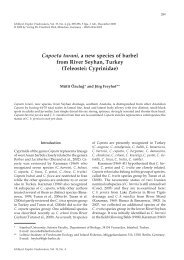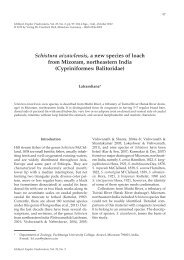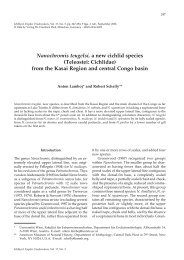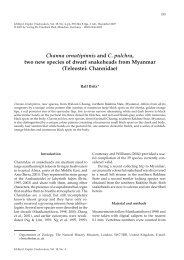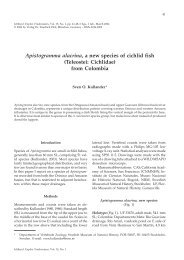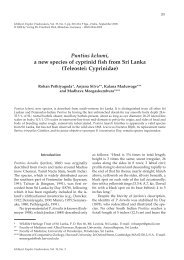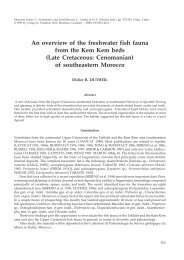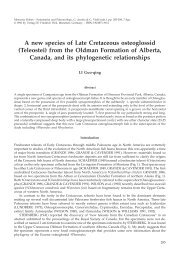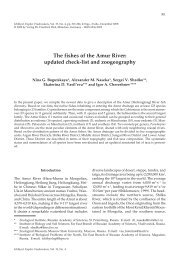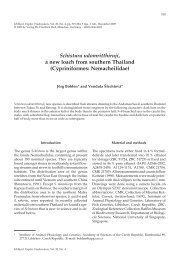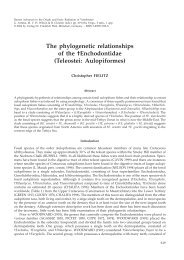Microcobitis, a new genus name for Cobitis misgurnoides (Teleostei ...
Microcobitis, a new genus name for Cobitis misgurnoides (Teleostei ...
Microcobitis, a new genus name for Cobitis misgurnoides (Teleostei ...
Create successful ePaper yourself
Turn your PDF publications into a flip-book with our unique Google optimized e-Paper software.
295<br />
Ichthyol. Explor. Freshwaters, Vol. 21, No. 4, pp. 295-300, 5 figs., December 2010<br />
© 2010 by Verlag Dr. Friedrich Pfeil, München, Germany – ISSN 0936-9902<br />
<strong>Microcobitis</strong>, a <strong>new</strong> <strong>genus</strong> <strong>name</strong> <strong>for</strong> <strong>Cobitis</strong> <strong>misgurnoides</strong><br />
(<strong>Teleostei</strong>: Cobitidae)<br />
Jörg Bohlen* and Radovan Harant**<br />
<strong>Microcobitis</strong>, <strong>new</strong> <strong>genus</strong>, is established with <strong>Cobitis</strong> <strong>misgurnoides</strong> Rendahl, 1944 as type species. It is diagnosed by<br />
having the lower lip developed into four barbel-like lobes, adult males bearing a lamina circularis at the base of<br />
the second pectoral-fin ray, suborbital spine in a groove under the eye and not covered by skin, a pre-epiphysal<br />
fontanel between the frontal bones, a cartilaginous epiphysal bar, and the absence of body swellings in males.<br />
Introduction<br />
The <strong>genus</strong> <strong>Cobitis</strong> is the largest and most widespread<br />
within the loach family Cobitidae, ranging<br />
nearly continuously from the Atlantic coast in<br />
Europe to the Pacific coast in East Asia (Bânârescu,<br />
1991). The <strong>genus</strong> contains about 30 species<br />
and shows in most cases a rather homogenous<br />
appearance with a slender body up to 180 mm<br />
SL, a long snout (37-52 % HL) and four longitudinal<br />
rows of black pigmentation on the body<br />
sides (‘Gambetta zones’ I to IV) on a light whitish<br />
or yellowish background colour. However, there<br />
are some species that differ from this general<br />
pattern, and one of these exceptions is C. <strong>misgurnoides</strong><br />
Rendahl, 1944 (Fig. 1). Rendahl introduced<br />
this <strong>new</strong> species with a very detailed and accurate<br />
description basing on 26 specimens; from this<br />
description it became clear that C. <strong>misgurnoides</strong><br />
differs from all other species of <strong>Cobitis</strong> in several<br />
characters: It is smaller than all other species of<br />
<strong>Cobitis</strong>, reaching only up to 41 mm SL, has a<br />
shorter (29-40 % head length) and more rounded<br />
snout than most <strong>Cobitis</strong> and bears a midlateral<br />
row of brown blotches, an unclear mid-dorsal<br />
row and irregular blotches between these rows.<br />
Most importantly, it differs from all species of<br />
<strong>Cobitis</strong> in the shape of the lower lip, which is<br />
divided into four barbel-like projections. In a<br />
recent genetic review of the genera within the<br />
family Cobitidae, Šlechtová et al. (2008) demonstrated<br />
that C. <strong>misgurnoides</strong> is not a member of<br />
the <strong>genus</strong> <strong>Cobitis</strong>, but represents an independent<br />
monophyletic lineage that is distinct from all<br />
<strong>name</strong>d genera. There is no available <strong>name</strong> <strong>for</strong> this<br />
<strong>genus</strong> and the aim of the present note is to establish<br />
a <strong>for</strong>mal generic <strong>name</strong> <strong>for</strong> C. <strong>misgurnoides</strong><br />
Rendahl.<br />
* Institute of Animal Physiology and Genetics, Academy of Sciences of the Czech Republic, Rumburská 89,<br />
277 21 Libechov, Czech Republic. E-mail: bohlen@iapg.cas.cz<br />
** Department of Zoology, Faculty of Science, University of South Bohemia, Branišovská 31, 37005 Ceské Budejovice,<br />
Czech Republic.<br />
Ichthyol. Explor. Freshwaters, Vol. 21, No. 4
296<br />
Material and methods<br />
Institutional abbreviations: BMNH, Natural History<br />
Museum, London; FRLM, Fisheries Research<br />
Laboratory, Mie University, Mie; IAPG, Institute<br />
of Animal Physiology and Genetics, Libechov;<br />
SJB, Collection of first author, ZFMK, Alexander<br />
Koenig Research Museum, Bonn; ZRC, Zoological<br />
Reference Collection, Raffles Museum of Biodiversity<br />
Research, National University of Singapore.<br />
All measurements follow Kottelat (1990) and<br />
were made point-to-point with a pair of dial callipers<br />
to the nearest 0.1 mm. Head length (HL)<br />
was measured as lateral head length from the tip<br />
of the snout to the posterior most point of opercle.<br />
Terminology of neurocranial bones, epiphysial<br />
bar and fontanelles follows Sawada (1982) modified<br />
according to Conway & Mayden (2008); and<br />
nomenclature of mouth and lamina circularis<br />
structures is adopted from Rendahl (1944). Osteological<br />
characters were taken from three<br />
cleared and stained specimens prepared following<br />
Taylor & Van Dyke (1985). Length of metapterygoid-quadrate<br />
fenestra is the maximum distance<br />
along the axis passing through the centres of<br />
metapterygoid and quadrate and was measured<br />
using an ocular micrometer. All drawings were<br />
prepared with the aid of a camera lucida on an<br />
Olympus SZX7 microscope.<br />
The relevant in<strong>for</strong>mation <strong>for</strong> the genera<br />
Bibarba, Paralepidocephalus and Protocobitis were<br />
obtained from Chen & Chen (2007), Li (2004),<br />
Yang et al (1994) and Zhu et al. (2008).<br />
<strong>Microcobitis</strong>, <strong>new</strong> <strong>genus</strong><br />
Type species. <strong>Cobitis</strong> <strong>misgurnoides</strong> Rendahl, 1944.<br />
Diagnosis. Within the family Cobitidae, <strong>Microcobitis</strong><br />
differs from the genera Acanthopsoides,<br />
Bibarba, Canthophrys, <strong>Cobitis</strong>, Enobarbus, Iksookimia,<br />
Kichulchoia, Lepidocephalichthys, Lepidocephalus,<br />
Neoeucirrhichthys, Niwaella, Paralepidocephalus,<br />
Pangio, Protocobitis and Sabanejewia by having the<br />
lower lip extended into four barbel-like lobes<br />
(labial barbels) (Fig. 2) (vs. not extended or extended<br />
into two lobes). Four labial barbels are<br />
found in all species of the genera Misgurnus,<br />
Koreocobitis and Paramisgurnus as well as in one<br />
species each of Kottelatlimia (K. katik) and Acantopsis<br />
(A. sp.). The remaining species of Kottelatlimia<br />
and Acantopsis have two labial barbels.<br />
<strong>Microcobitis</strong> differs from Misgurnus and Paramisgurnus<br />
by having the groove of the erectible<br />
suborbital spine (lateral ethmoid) open (vs. covered<br />
by skin) and by its small body size (maximum<br />
41 mm SL vs. 130-300 mm SL). It differs from<br />
Koreocobitis, Misgurnus and Paramisgurnus by the<br />
absence of an elongated lateral protuberance<br />
between level of dorsal and anal fin in both<br />
sexes (vs. presence in adult males). <strong>Microcobitis</strong><br />
differs from Acantopsis and <strong>Cobitis</strong> arenae by having<br />
the suborbital spine under the eye (vs. in front<br />
of the eye). It further differs from Acantopsis by<br />
its shorter snout (29-40 % HL vs. 58-68 % HL) and<br />
by having a lamina circularis on the second<br />
pectoral-fin ray in adult males (vs. absence).<br />
<strong>Microcobitis</strong> differs from Kottelatlimia by having a<br />
smooth, semi-circle-shaped and horizontally<br />
oriented lamina circularis that represents a single<br />
projection from the proximal-most segment of<br />
the dorsal ramus (upper hemitrichium) of the<br />
second ray (Fig. 3) (vs. a serration along the posterior<br />
edge of middle segments of the first<br />
branched pectoral-fin ray) and by the absence of<br />
supraorbitals (vs. presence). Moreover, <strong>Microcobitis</strong><br />
differs from all other genera of Cobitidae by<br />
the presence of a narrow cartilaginous epiphysial<br />
bar located between the medial processes of the<br />
frontals (vs. absence) and by the presence of a<br />
tear-drop shaped pre-epiphysial fontanelle located<br />
between the frontals and in front of the<br />
epiphysal bar (vs. absence) (Fig. 4).<br />
Etymology. The <strong>name</strong> is derived from the Greek<br />
word ‘micros’, small, used as prefix here, and the<br />
generic <strong>name</strong> <strong>Cobitis</strong>, the type <strong>genus</strong> of Cobitidae,<br />
in which <strong>Microcobitis</strong> was originally placed due<br />
to the similar shape of the lamina circularis in<br />
males. Gender feminine.<br />
Distribution. Presently reported from river basins<br />
in Central Vietnam. <strong>Microcobitis</strong> has also been<br />
reported to occur in some tributaries of the Mekong<br />
in Laos on the western slope of the Annamite<br />
range (M. Kottelat, pers. comm.).<br />
Remarks. Most species of Cobitidae show a<br />
pronounced sexual dimorphism, especially modifications<br />
of the pectoral-fin rays in adult males,<br />
which are absent in juveniles and females. Usually,<br />
the second fin ray is thicker and longer than<br />
in females, but in <strong>Cobitis</strong>, Iksookimia, Misgurnus<br />
and Paramisgurnus, the males additionally bear a<br />
Bohlen & Harant: <strong>Microcobitis</strong>
297<br />
Fig. 1. <strong>Microcobitis</strong> <strong>misgurnoides</strong>, male, about 25 mm SL; Vietnam: river Thua Luu; same locality as ZFMK 27528-<br />
27554.<br />
plate- or finger-like extension (lamina circularis)<br />
at the base of the second pectoral-fin ray. Males<br />
of <strong>Microcobitis</strong> bear a lamina circularis that is very<br />
similar to that of some species of <strong>Cobitis</strong>, which<br />
led Rendahl (1944) and later authors to the conclusion<br />
that M. <strong>misgurnoides</strong> belongs to <strong>Cobitis</strong>. The<br />
shape of the lamina circularis in <strong>Cobitis</strong> is speciesspecific<br />
and includes triangular, axe-shaped and<br />
elongated types. The lamina circularis in <strong>Microcobitis</strong><br />
resembles the axe-shape type, but differs<br />
from similar ones in <strong>Cobitis</strong> by its nearly oval<br />
shape (vs. axe-shaped) and a relatively small<br />
1 mm<br />
rb<br />
ul<br />
of<br />
distal part that is not connected to the fin ray<br />
(length of free distal part 4-5 times in length of<br />
connected part; vs. 0.8-2 times in <strong>Cobitis</strong>). Most<br />
species of <strong>Cobitis</strong> have three distinct longitudinal<br />
lc dr vr<br />
fr 1 fr 2<br />
1 mm<br />
Fig. 3. <strong>Microcobitis</strong> <strong>misgurnoides</strong>, ZMFK 275228, 27.3 mm<br />
SL; dorsal view of first two pectoral-fin rays of left side.<br />
Abbreviations: dr, dorsal ramus (upper hemitrichium)<br />
of second ray; fr 1 , first ray; fr 2 , second ray; lc, lamina<br />
circularis; vr, ventral ramus (lower hemitrichium) of<br />
second ray.<br />
ll<br />
mpf<br />
sph pa pt<br />
so<br />
eo<br />
ilb<br />
fr<br />
mb<br />
1 mm<br />
lof<br />
olb<br />
mmb<br />
Fig. 2. <strong>Microcobitis</strong> <strong>misgurnoides</strong>, ZMFK 27531, 25.4 mm<br />
SL; ventral view of mouth. Abbreviations: ilb, inner<br />
labial barbel; ll, lower lip; mb, maxillary barbel; mmb,<br />
maxillo-mandibular barbel; of, oral fissure; olb, outer<br />
labial barbel; rb, rostral barbel; ul, upper lip.<br />
prf eb pof ep<br />
Fig. 4. <strong>Microcobitis</strong> <strong>misgurnoides</strong>, ZMFK 275229, 27.0 mm<br />
SL; dorsal view of neurocranium; ethmoid region omitted<br />
from image. Abbreviations: eb, epiphysial bar;<br />
eo, exoccipital; ep, epiotic; fr, frontal; lof, lateral occipital<br />
<strong>for</strong>amen; mpf, medial process of frontal; pa, parietal;<br />
pof, post-epiphysial fontanelle; prf, pre-epiphysial<br />
fontanelle; pt, pterotic; sph, sphenotic; so, supraoccipital.<br />
Ichthyol. Explor. Freshwaters, Vol. 21, No. 4
298<br />
qd<br />
mqf<br />
mp<br />
0.5 mm<br />
usually five, rarely four hypurals (vs. three or<br />
four hypurals). Interestingly, <strong>Microcobitis</strong> shares<br />
these five character states with one or more species<br />
in the genera Kottelatlimia, Lepidocephalichthys<br />
and Pangio, which are phylogenetically not closely<br />
related, suggesting a parallel evolution in<br />
several characters.<br />
pdq<br />
sy<br />
Fig. 5. <strong>Microcobitis</strong> <strong>misgurnoides</strong>, ZMFK 275228, 27.3 mm<br />
SL; shape of metapterygoid-quadrate-fenestra. Cartilage<br />
has been omitted from image. Abbreviations: mp, metapterygoid;<br />
mqf, metapterygoid-quadrate fenestra;<br />
pdq, postero-dorsal notch of quadrate; qd, quadrate;<br />
sy, symplectic.<br />
rows of blotches; one along the dorsal midline,<br />
one along the lateral midline and one at about<br />
half distance between these two. The interspaces<br />
between these rows are irregularly dotted, marmorated<br />
or without pigmentation. In <strong>Microcobitis</strong>,<br />
the intermediate row of blotches is missing or<br />
very irregular, while the whole area between<br />
dorsal and lateral row of blotches is filled with<br />
irregular dots.<br />
<strong>Microcobitis</strong> has a narrow cartilaginous epiphysial<br />
bar and a pre-epiphysial fontanelle. Both<br />
structures are present in other species of Cyprini<strong>for</strong>mes<br />
(e. g. in Psilorhynchidae and Cyprinidae)<br />
(Britz & Kottelat, 2008; Conway & Mayden, 2008),<br />
but not in any other species of Cobitidae.<br />
As revealed by a recent genetic study, <strong>Microcobitis</strong><br />
is closely related to the genera <strong>Cobitis</strong>,<br />
Iksoo kimia, Kichulchoia, Koreocobitis, Misgurnus,<br />
Niwaella, Paramisgurnus and Sabanejewia. All these<br />
genera together <strong>for</strong>m a monophyletic lineage<br />
within the family Cobitidae (Šlechtová et al., 2008).<br />
This monophyletic lineage includes all species<br />
with a lamina circularis in males, suggesting that<br />
this is the defining synapomorphy (although<br />
secondarely reduced in some species). Within this<br />
lineage, M. <strong>misgurnoides</strong> differs from all species<br />
of the other genera by reaching a maximum size<br />
of 41 mm SL (vs. ranging from 60 to 300 mm SL<br />
in the other included species), by having 35-36<br />
vertebrae (vs. 40-52), a small metapterygoidquadrate-fenestra<br />
(maximum length up to 50 %<br />
of length of metapterygoid vs. metapterygoidquadrate-fenestra<br />
either absent or maximum<br />
length more than 60 % of length of metapterygoid)<br />
(Fig. 5), by having a shallow postero-dorsal notch<br />
of quadrate (length not more than half the height<br />
vs. deep, as long as high or longer) and by having<br />
Material examined. <strong>Cobitis</strong> <strong>misgurnoides</strong>: ZFMK 27558-<br />
27578, 21, 22.5-28.0 mm SL; Vietnam: Thua Thien Hue<br />
Prov.: un<strong>name</strong>d stream 1.5 km west of Thua Luu. –<br />
ZFMF 27584-27597, 14, 21.9-26.5 mm SL; Vietnam:<br />
Quang Tri Prov.: stream Bau Dung. – ZFMK 27598, 1,<br />
32.0 mm SL; Vietnam: Quang Binh Prov.: stream running<br />
to river Giang. – ZMFK 27528-27554, 29, 23.8-34.4 mm<br />
SL; ZMFK 41774-41776, 3 (cleared & stained), 30.4-<br />
32.2 mm SL; Vietnam: Thua Thien Hue Prov.: river Thua<br />
Luu.<br />
Comparative material. Acanthopsoides delphax: IAPG<br />
uncat., 1; Thailand: Chiang Mai Prov.: Nam Mae<br />
Chaem. A. gracilentus: IAPG uncat., 3; Thailand: Phayao<br />
Prov.: tributary of Nam Mae Ing. A. hapalias: IAPG<br />
uncat., 10; Thailand: Ubon Ratchathani Prov.: River<br />
Huai Chaera Mae. A. robertsi: IAPG uncat., 1; Malaysia:<br />
Sarawak Prov.: River Noren. – IAPG uncat., 1; Malaysia:<br />
Sarawak Prov.: River Sebako.<br />
Acantopsis sp.: IAPG uncat., 1; Thailand: Ubon<br />
Ratchanthani Prov.: River Huai Yang. A. sp.: IAPG<br />
uncat., 2; or<strong>name</strong>ntal fish trade.<br />
Canthophrys gongota: IAPG A0175, 1; or<strong>name</strong>ntal<br />
fish trade. – IAPG A0497-0499, 3; Bangladesh: Dhaka<br />
Prov.: fish market in Sutabala.<br />
<strong>Cobitis</strong> arenae: IAPG A3379-3383, 5: Vietnam: Quang<br />
Nam Prov.: River Vinh Dien. C. bilineata: IAPG uncat.,<br />
2; Italy: Trient Prov.: Lago di Ledro. – SJB 2529-2531,<br />
3; Italy: Lombardy Prov.: Lake Garda. C. bilseli: IAPG<br />
uncat., 2; Turkey: Konya Prov.: Lake Beysehir. C. calderoni:<br />
BMNH 1986.7.772-78, 7; Spain: Castilla y Leon<br />
Prov.: River Ucero. C. dalmatina: IAPG uncat., 2; Croatia:<br />
Dalmatia Prov.: River Cetina. C. elazigensis: IAPG<br />
uncat., 2; Turkey: Malatya Prov.: River Muhrat Nehri.<br />
C. elongata: IAPG uncat., 7; Bulgaria: Pleven Prov.:<br />
River Vit. C. hangkugensis: IAPG uncat., 2; South Korea:<br />
Jeon La Nam Do Prov.: River Jin Am Gan. C. laoensis:<br />
IAPG uncat., 4; Vietnam: Quang Nam Prov.: River Hoc<br />
Sen. C. levantina: IAPG uncat., 1; Turkey: Hatay Prov.:<br />
River Orontes. C. lutheri: IAPG uncat., 1; South Korea,<br />
Chung Cheong Bun Do Prov.: River Mi Ho Cheon. C. ohridana:<br />
IAPG uncat., 7; Montenegro: Podgorica Prov.:<br />
River Moraca. C. pacifica: 2; South Korea: Gang Won<br />
Do Prov.: River Su Yog Cheon. C. paludica: IAPG uncat.,<br />
2; Spain: Huelva Prov.: River Murtiga. C. rara: IAPG<br />
uncat., 1; PR China: or<strong>name</strong>ntal fish trade. C. strumicae:<br />
IAPG uncat., 5; Bulgaria: Pleven Prov.: River Vit.<br />
C. taenia: IAPG uncat., 6; Germany: Schleswig-Holstein<br />
Prov.: Kleiner Plöner See. – IAPG uncat., 6; Germany:<br />
Niedersachsen Prov.: Stream Haaren. C. vettonica: SJB<br />
Bohlen & Harant: <strong>Microcobitis</strong>
299<br />
5004-5005, 2; Spain: Caceres Prov.: River Arrago.<br />
Enobarbus maculatus: BMNH 1868.10.27.36, 1; India:<br />
Tamil Nadu Prov.: surrounding of Chennai.<br />
Iksookimia koreensis: IAPG uncat., 3; South Korea:<br />
Gyeong Gi Do Prov.: River Han Tan Gong. – IAPG<br />
uncat., 6; South Korea: Gyeong Gi Do Prov.: River Han<br />
Tan Gong. I. longicorpa: IAPG uncat., 2; South Korea:<br />
Gyeong Sang Nam Do Prov.: River Jin Geon Cheon.<br />
I. pumila: IAPG uncat., 2; South Korea: Chollabuk Do<br />
Prov.: River Paikchon. I. yongdokensis: IAPG uncat., 1;<br />
South Korea: Gyeong San Bun Do Prov.: River Chuk<br />
San Cheon.<br />
Kichulchoia brevifasciata: IAPG uncat., 2; South<br />
Korea: Chollanam Do Prov.: Koup Stream.<br />
Koreocobitis rotundicauda: IAPG uncat., 2; South<br />
Korea: Gang Won Do Prov.: River Jeon Cheon.<br />
Kottelatlimia katik: ZRC 50400, 8; Malaysia: Johor<br />
Prov.: un<strong>name</strong>d peat swamp. K. pristes: IAPG uncat., 5;<br />
Malaysia: Sarawak Prov.: un<strong>name</strong>d <strong>for</strong>rest stream. –<br />
IAPG A 2700-2708, 9; or<strong>name</strong>ntal fish trade.<br />
Lepidocephalichthys berdmorei: IAPG uncat., 3; Thailand:<br />
Mae Hong Son Prov.: River Huai Mae Pang. – IAPG<br />
uncat., 5; Thailand: Mae Hong Son Prov.: River Nam<br />
Mae Sariang. L. hasselti: IAPG uncat., 3; Thailand:<br />
Phayao Prov.: River Mae Nam Yom. L. irrorata: IAPG<br />
A1006-111, 3; or<strong>name</strong>ntal fish trade. L. thermalis: IAPG<br />
A280, 281, 398, 119, 4; or<strong>name</strong>ntal fish trade.<br />
Lepidocephalus macrochir: IAPG uncat., 3; Thailand:<br />
no details known.<br />
Misgurnus anguillicaudatus: IAPG A2218-2219, 2;<br />
China: Guangxi Prov.: market in Pingxiang. M. fossilis:<br />
IAPG uncat., 1; Czech Republic: South Moravian<br />
Prov.: River Morava. – IAPG A0442-0456, 15; Germany:<br />
Schleswig-Holstein Prov.: River Eider. Misgurnus<br />
sp.: IAPG uncat., 1; South Korea: Gang Won Do Prov.:<br />
River Cheon Jin Cheon. – IAPG uncat., 2; South Korea:<br />
Gyeong Gi Do Prov.: River Han Tan Gong. – IAPG<br />
uncat., 4; South Korea: Gyeong San Bun Do Prov.:<br />
River Chuk San Cheon.<br />
Niwaella delicata: BMNH 1998.8.21.3-8, 4; Japan:<br />
Gifu Prov.: River Kiso. – FRLM 29280-29281, 29778,<br />
29796-29797, 5; Japan: Mie Prov.: River Miya. N. multifasciata:<br />
IAPG uncat., 2; South Korea: Gyeong Sang Nam<br />
Do Prov.: River Im Cheon Gang.<br />
Pangio anguillaris: IAPG uncat., 20; Thailand: Ubon<br />
Ratchathani Prov.: River Huai Chaera Mae. P. doriae:<br />
IAPG uncat., 4; Malaysia: Sarawak Prov.: River<br />
Noren. – IAPG A0001-0002, 2; or<strong>name</strong>ntal fish trade.<br />
P. cuneovirgata: IAPG A2709-2710, 2; Indonesia: no<br />
details known. P. semicincta: IAPG uncat., 5; Indonesia:<br />
Jambi Prov.: River Batanghari. – IAPG uncat., 12; or<strong>name</strong>ntal<br />
fish trade. P. oblonga: IAPG uncat., 14; or<strong>name</strong>ntal<br />
fish trade. P. semicincta: IAPG uncat., 13; Malaysia:<br />
Johor Prov.: un<strong>name</strong>d <strong>for</strong>rest stream. P. shel<strong>for</strong>dii:<br />
IAPG uncat., 8; Malaysia: Sarawak Prov.: River<br />
Noren. – IAPG uncat., 1; Malaysia: Sarawak Prov.:<br />
River Sebako. – IAPG uncat., 2; Malaysia: Sarawak Prov.:<br />
River Engkabang. P. sp.: IAPG uncat., 3; Malaysia:<br />
Sarawak Prov.: River Noren.<br />
Paramisgurnus dabryanus: SJB 4636-4637, 2; or<strong>name</strong>ntal<br />
fish trade. – IAPG A409, 1; China: Hubei Prov.:<br />
market in Wuhan.<br />
Sabanejewia balcanica: IAPG uncat., 5; Romania:<br />
Caras-Severin Prov.: River Nera. – IAPG uncat., 2;<br />
Bulgaria: Pleven Prov.: River Vit. S. baltica: IAPG uncat.,<br />
6; Ukraine: Lviv Prov.: River Dnjester. S. vallachica:<br />
IAPG uncat., 5; Romania: Prahova Prov.: River<br />
Ialomitza.<br />
Acknowledgements<br />
We are grateful to Jörg Freyhof and Maurice Kottelat<br />
<strong>for</strong> their highly valuable advices. This study was financed<br />
by grants 206/08/0637 and 206/05/2556 of the<br />
Czech Science Foundation, No A600450508 of the Grant<br />
Agency of the Academy of Sciences of the Czech Republic<br />
and by the IRP IAPG No. AV0Z50450515.<br />
Literature cited<br />
Banarescu, P. 1991. Zoogeography of fresh waters. Vol.<br />
II. Distribution and dispersal of freshwater animals<br />
in North America and Eurasia. Aula, Wiesbaden,<br />
572 pp.<br />
Britz, R. & M. Kottelat. 2008. Paedocypris carbunculus, a<br />
<strong>new</strong> species of miniature fish from Borneo (<strong>Teleostei</strong>:<br />
Cyprini<strong>for</strong>mes: Cyprinidae). Raffles Bulletin<br />
of Zoology, 56: 415-422.<br />
Chen, Y.-X. & Y.-F. Chen. 2007. Bibarba bibarba: a <strong>new</strong><br />
<strong>genus</strong> and species of Cobitinae (Pisces: Cyprini<strong>for</strong>mes:<br />
Cobitidae) from Guangxi Province (China).<br />
Zoologischer Anzeiger, 246: 103-113.<br />
Conway, K. W. & R. L. Mayden. 2008. Psilorhynchus<br />
breviminor, a <strong>new</strong> species of psilorhynchid fish from<br />
Myanmar (Ostariophysi: Psilorhynchidae). Ichthyological<br />
Exploration of Freshwaters, 19: 111-<br />
120.<br />
Kottelat, M. 1990. Indochinese namacheilines. A revision<br />
of nemacheiline loaches (Pisces: Cyprini<strong>for</strong>mes) of<br />
Thailand, Burma, Laos, Cambodia and southern<br />
Viet Nam. Pfeil, München, 262 pp.<br />
Li, W.-X. 2004. The three <strong>new</strong> species of Cobitidae <strong>for</strong>m<br />
Yunnan, China. Journal of the Jishou University,<br />
Natural Science Edition, 25: 93-96.<br />
Rendahl, H. 1944. Einige Cobitiden von Annam und<br />
Tonkin. Göteborgs Kungliga Vetenskaps och Vitterhets<br />
Samhällas Handlingar, Series B, Matematiska<br />
och Naturvetenskapliga Skrifter, 3: 1-54.<br />
Sawada, Y. 1982. Phylogeny and zoogeography of the<br />
superfamily Cobitoidea (Cyprinoidei, Cyprini<strong>for</strong>mes).<br />
Memoirs of the Faculty of Fisheries,<br />
Hokkaido University, 28: 65-223.<br />
Šlechtová, V., J. Bohlen & A. Perdices. 2008. Molecular<br />
phylogeny of the freshwater fish family Cobitidae<br />
(Cyprini<strong>for</strong>mes: <strong>Teleostei</strong>): delimitation of genera,<br />
Ichthyol. Explor. Freshwaters, Vol. 21, No. 4
300<br />
mitochondrial introgression and evolution of sexual<br />
dimorphism. Molecular Phylogenetics and<br />
Evolution, 47: 812-831.<br />
Taylor, W. R. & G. C. Van Dyke 1985. Revised procedures<br />
<strong>for</strong> staining and clearing small fishes and other<br />
vertebrates <strong>for</strong> bone and cartilage study. Cybium<br />
9: 107-119.<br />
Yang, J.-X., Y.-R. Chen & J.-H. Lan. 1994. Protocobitis<br />
typhlops, a <strong>new</strong> <strong>genus</strong> and species of cave loach from<br />
China (Cyprini<strong>for</strong>mes: Cobitidae). Ichthyological<br />
Exploration of Freshwaters, 5: 91-96.<br />
Zhu, Y., Y.-J. Lü, J.-X. Yang & S. Zhang. 2008. A <strong>new</strong><br />
blind underground species of the <strong>genus</strong> Protocobitis<br />
(Cobitidae) from Geangxi, China. Zoological Research,<br />
29: 452-454.<br />
Received 20 November 2009<br />
Revised 8 July 2010<br />
Accepted 20 September 2010<br />
Bohlen & Harant: <strong>Microcobitis</strong>




